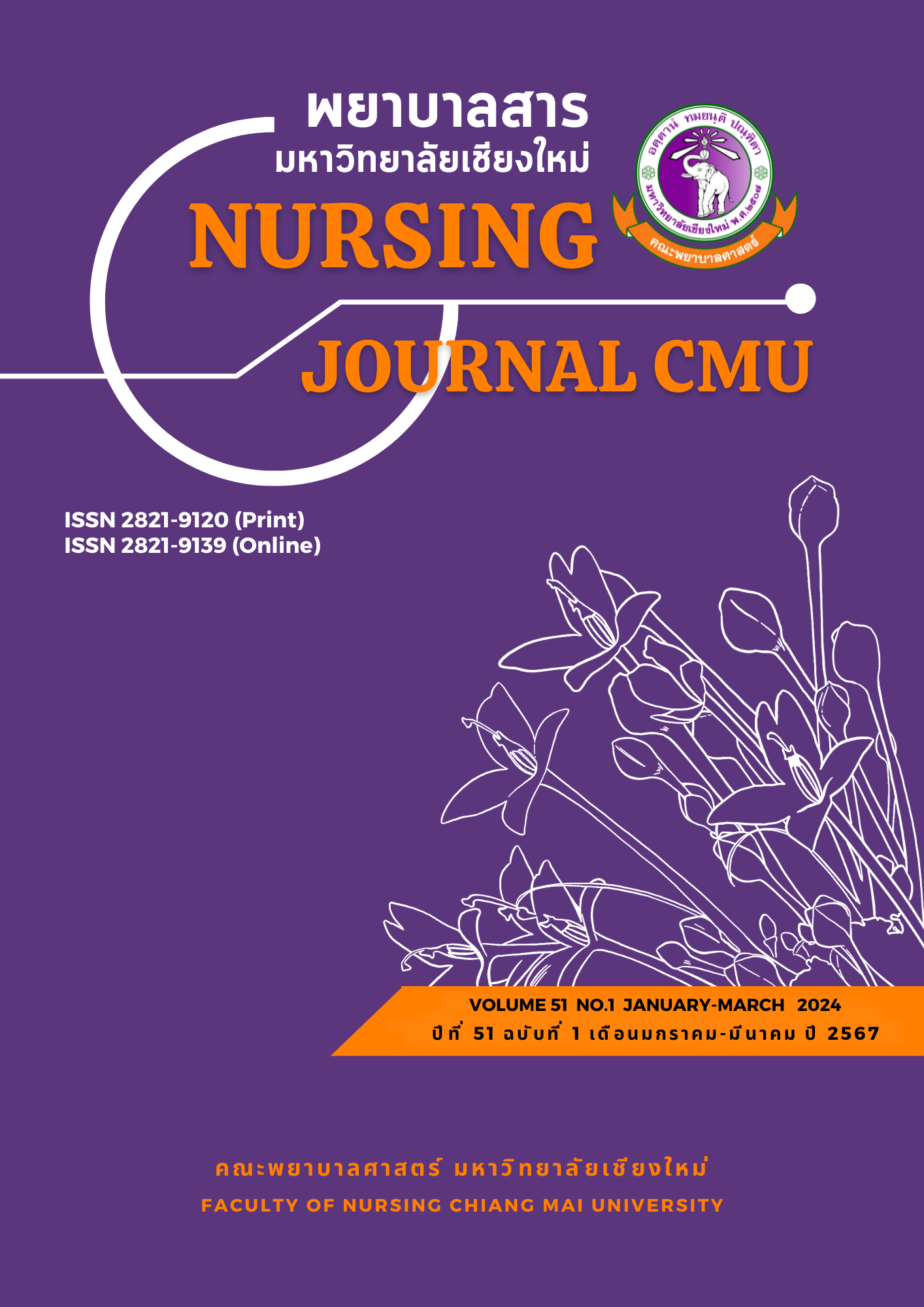The Development and Effects of a Clinical Nursing Practice Guideline for Amphetamine Patients with Aggressive Behaviors in Regional Health 12
Keywords:
Clinical nursing practice guideline, Methamphetamine patients, Aggressive behaviorsAbstract
Clinical nursing practice guidelines are guidelines developed from a review of empirical evidence to be used to support nurses’ decision-making in providing appropriate patient health care. This research and development aimed to develop and evaluate nursing guidelines for amphetamine patients with aggressive behavior. The development process has 2 phases: 1) develop guidelines by determining the problems, review the literature, develop draft guidelines check, and evaluate the quality of the guidelines by 5 experts, and 2) Evaluate the effectiveness of the guidelines. The sample consisted of registered nurses and amphetamine patients with aggressive behavior. Multi-stage sampling was used to select 30 hospitals from hospitals with drug clinics in Health Region 12 (7 provinces, 89 hospitals). Thirty nurses were selected by purposive sampling while 60 amphetamine patients were equally and randomly assigned to either the experimental or control group. The experimental instrument was the nursing guidelines for amphetamine patients with aggressive behavior. The data collection instruments were a satisfaction assessment and the feasibility of the use of guidelines for nurses, and an aggressive behavior scale for patients. Chi-square statistics and t-tests were used for data analysis.
The results found that:
1. The nursing guidelines for amphetamine patients consisted of 3 phases of the nursing process: pre-event, during event, and post event. Content validity (CVI) = .96, AGREE II value = 89.29%, feasibility of use = 90-100%, and overall satisfaction with the use of the guidelines was at a high level (M = 3.00)
2. After implementing the nursing guidelines, significantly lower aggressive behavior mean scores were found, between after (M = 1.33, SD = 1.54) and before (M = 10.80, SD = 3.20), (t = 17.68, p < .05). The mean scores for aggressive behavior of patients in the experimental group who received the guidelines (M = 1.33, SD = 1.54) were significantly lower than those in the control group who received usual care (M = 10.87, SD = 3.31) (t = -14.31, p < .05).
This guideline could be used in caring for amphetamine patients with aggressive behavior in other hospitals.
References
Adeniyi, O. V., & Puzi, N. (2021). Management approach of patients with violent and aggressive behaviour in a District Hospital setting in South Africa. South African Family Practice: Official Journal of the South African Academy of Family Practice/Primary Care, 63(1), e1–e7. https://doi.org/10.4102/safp.v63i1.5393
Agree Next Steps Consortium. (2017). The agree II instrument. http://www.agreetrust.org
Cohen, J. (1988). Statistical power analysis for the behavioral sciences (2nd ed.). Hillsdale.
Kuypers, K., Verkes, R., van den Brink, W., van Amsterdam, J., & Ramaekers, J. (2020). Intoxicated aggression: Do alcohol and stimulants cause dose-related aggression? A review. European Neuropsychopharmacology, 30, 114–147. https://doi.org/10.1016/j.euroneuro.2018.06.001
Li, K. X., & Loshak, H. (2019). Treatment for methamphetamine addiction: A review of guidelines. Canadian Agency for Drugs and Technologies in Health. http://www.ncbi.nlm.nih.gov/books/NBK546585/
Ministry of Public Health. (2023). National drug addiction treatment and rehabilitation information system. Office of the Secretary of the Drug Addiction Treatment and Rehabilitation Committee. https://antidrugnew.moph.go.th
National Health and Medical Research Council [NHMRC]. (1999). A guide to the developmental, implementation and evaluation of clinical practice guidelines. https://www.nhmrc.gov.au/sites/default/files/images/a-guide-to-the-development-and-evaluation-of-clinical-practice-guidelines.pdf
Office of the Narcotics Control Board. (2021). Annual report 2021. Office of the Narcotics Control Board Ministry of justice.
Panthasi, P. (2020). Nursing process & functional health pattern: Application in clinical practice. Aksorn. (in Thai)
Raddussadee, T., Ruchiwit, M., & Uthis, P. (2014). The effect of a biofeedback and autogenic training program on aggressive behavior levels of amphetamine abusers. The Journal of Psychiatric Nursing and Mental Health, 28(1), 92-104. (in Thai)
Ragsasaup, S., Sawangwongsin, S., & Suriyapan, N. (2021). Development of clinical practice guideline for nursing care violence behavior of schizophrenia patients in Srithanya Hospital. Medical Journal of Srisaket Surin Buriram Hospitals, 36(1), 159-168. (in Thai)
Ridthidech, A., Wannakit, U., Salaema, A., & Salaeama, A. (2023). The development and effectiveness of clinical nursing practice guidelines for schizophrenic patients with aggressive behavior: Mae Lan District, Pattani Province. Journal of Environmental and Community Health, 8(2), 175-184. (in Thai)
Rungsiwaroj, N., Bhatarasakoon, P., Phajuy, A., Chainonthi, A., & Chamchongkit, N. (2022). Development of evidence-based nursing practice guidelines for caring of patients with amphetamine induced psychotic disorders. The Journal of Psychiatric Nursing and Mental Health, 36(2), 180-203. (in Thai)
Samoh, W., Kongsuwan, W., & Suttarangsi, W. (2017). The development of clinical nursing practice guideline in keeping confidentiality of psychiatric patients, Yala Regional Hospital. The Southern College Network Journal of Nursing and Public Health, 4(2), 214-230. (in Thai)
Siriwatthano, K., Kongsuwan, V., & Intanon, T. (2017). Development of a clinical nursing practice guideline for schizophrenia patients with aggressive behaviors in the accident and emergency unit at Phrasaeng Hospital, Suratthani Province. Princess of Naradhiwas University Journal, 9(3), 25-36. (in Thai)
Songsang, T. (2011). The effect of cognitive behavioral therapy through face to face combine with line text messaging application program on amphetamine use in adolescent with amphetamine dependence [Master’s thesis, Chulalongkorn University]. https://digital.car.chula.ac.th/cgi/viewcontent.cgi?article=2572&context=chulaetd (in Thai)
Suwanmaitri, S., Usa, L., & Sianglam. (2020). Guidelines for caring for psychiatric patients emergency (Acute Care) for public health service units (levels A, S, M1 and M2), trial version. Beyond Publishing. (in Thai)
Tato, R. (2018). Nursing research: Concepts to application (3rd ed.). Chulalongkorn University Printing House. (in Thai)
Thanoi, S. (2018). Brain and neurotransmitter abnormalities in drug addiction. Rattanasuwan Printing. (in Thai)
Thanyarak Pattani Hospital. (2022). Statistics on patients receiving treatment. Thanyarak Pattani Hospital.
Wongratana, C., (2021). Techniques for using statistics for research (15th ed.). Amon Printing. (in Thai)
Yimyuean, S., Intanon, T., & Suttharangsee, W., (2011). Development of clinical nursing practice guideline in caring for schizophrenia patients substance dependence at Saunsaranrom Hospital. The Journal of Psychiatric Nursing and Mental Health, 25(1), 28-31. (in Thai)
Downloads
Published
How to Cite
Issue
Section
License
Copyright (c) 2024 Nursing Journal CMU

This work is licensed under a Creative Commons Attribution-NonCommercial-NoDerivatives 4.0 International License.
บทความที่ได้รับการตีพิมพ์เป็นลิขสิทธิ์ของวารสารพยาบาลสาร
ข้อความที่ปรากฏในบทความแต่ละเรื่องในวารสารวิชาการเล่มนี้เป็นความคิดเห็นส่วนตัวของผู้เขียนแต่ละท่านไม่เกี่ยวข้องกับมหาวิทยาลัยเชียงใหม่ และคณาจารย์ท่านอื่นๆในมหาวิทยาลัยฯ แต่อย่างใด ความรับผิดชอบองค์ประกอบทั้งหมดของบทความแต่ละเรื่องเป็นของผู้เขียนแต่ละท่าน หากมีความผิดพลาดใด ๆ ผู้เขียนแต่ละท่านจะรับผิดชอบบทความของตนเองแต่ผู้เดียว






